 |

Special Cooperation / East Japan Railway, HITACHI, Japan Airlines
 |
| Scenes from the Tournament |

November 15th (Sunday) The 2nd game, the handicap games

 |
| « Opening Ceremony » |
The second day of the tournament was blessed with a deep blue sky. On the Sunday, the parallel Araki Cup handicap tournaments are also held, so from early in the morning the Hotel Edmont Metropolitan in Iidabashi in Tokyo was thronged with nearly 400 participants.
In the halls where the handicap tournaments were being held, there were many teams made up of elementary-school pupils. One couldn’t help smiling at the sight of the children dressed in their best clothes waiting with tense expressions in the unfamiliar atmosphere for their games to start. In one corner of the hall where the Opening Ceremony was to be held, Satsuki and Nobuhira Tanaka could be seen rehearsing the pledge of fair play.
|

Reception desk for the Araki Cup handicap tournament
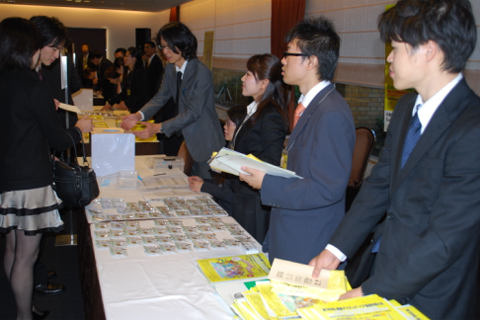
Reception desk for the Araki Cup handicap tournament
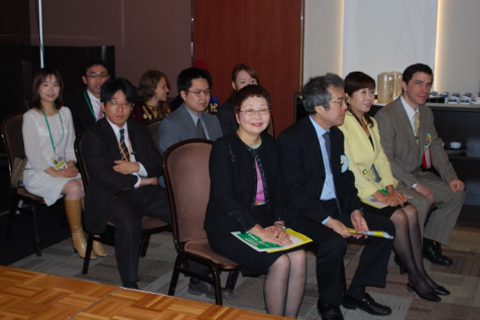
Seating area for guests
|
Like yesterday, the MC was Yoshiko Inaba, assisted by John Power as interpreter. All the tournament venues were linked up for sound, with speakers in the different rooms where the handicap tournaments were being held.
First of all, Hiroko Taki, Director and Secretary General of the Japan Pair Go Association, ascended the stage. ‘This year Pair Go is celebrating its coming of age [which is 20 in Japan]. I would like to express my gratitude to East Japan Railway and the other sponsors for their continuing support and also to all the Go fans of the world who have loved and fostered Pair Go. Since the first year, a total of 67 countries and and territories have been invited to participate in this tournament. In this year’s tournament, 32 pairs from 22 countries and territories are taking part, and the first round was held yesterday. In the handicap tournaments, 152 pairs, with players ranging in age from 5 to 88, are taking part. Last year Pair Go was an official event at the 1st World Mind Sports Games held in Beijing and the World Pair Go Association was founded. Pair Go, which was started in order to help popularize Go, has developed and become loved by people all around the world, and to be able to celebrate its 20th anniversary here with all of you is like a dream. I hope that all of you will enjoy the profundity of the game of Go today.’
|
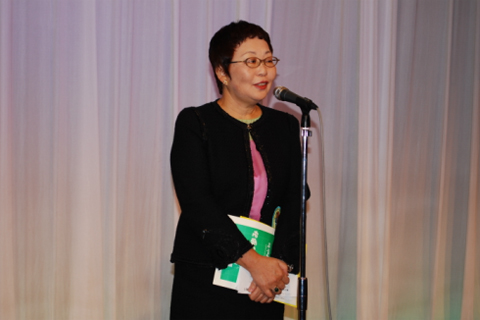
Call to start by Hiroko Taki,
Director and Secretary General of the Japan Pair Go Association
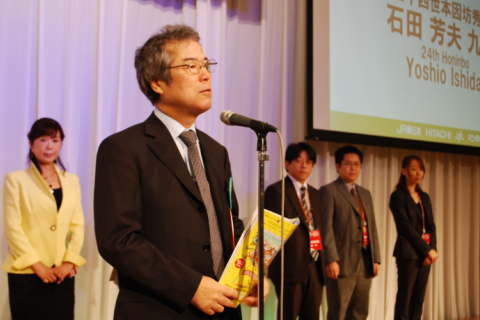
The Chief Referee, 24th Honinbo Shuho
Greetings and rules explanation
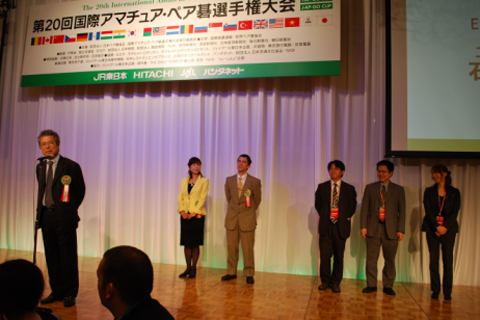
The Chief Referees, 24th Honinbo Shuho and Tomoko Ogawa 6-dan
The Referee, Michael Redmond 9-dan, and the other referees
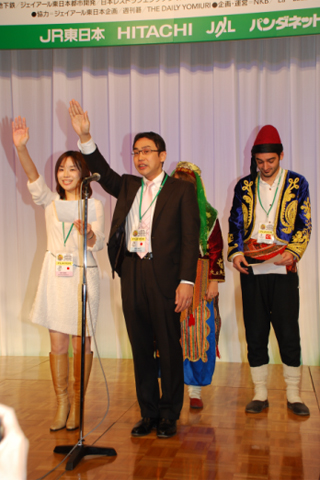
The pledge of fair play by the Japanese pair of
Satsuki and Nobuhira Tanaka (from the Kinki area)
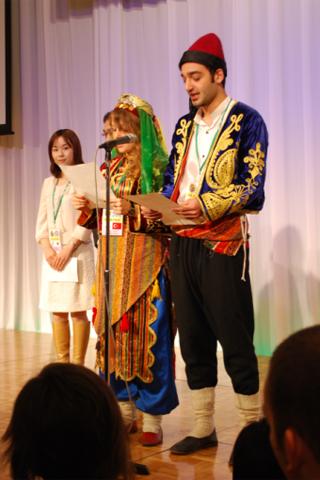
The pledge of fair play by the Turkish pair of
Neslihan Guch and Husrev Aksut
|
The Turkish pair, wearing national costume, and a Japanese pair (the Tanakas, who showed that their practice had paid off) then came up on to the stage to give the pledge of fair play, followed by the Chief Referee, 24th Honinbo Shuho, to declare the start of play.
Shuho commented: ‘Today is November 15. If you take the first syllables of 11-15 [ii igo], it means “good Go” [laughter from the audience]. November 15 is a Sunday only once every seven years. [Louder laughter] It’s impossible for everyone to win, but we can all aim at playing good Go. There are various kinds of good Go: games with good content, games that feel good. Everyone, please do your best to aim at playing good Go. Well, then, please begin your games!’
|
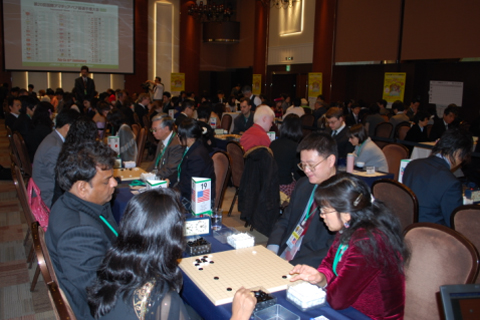
Main Tournament and A Block
|
« Main Tournament: Rounds 2 to 4 and
The Araki Cup Handicap Tournaments » |
The Japanese were aiming at their first win for ten years, but barring their way was, first of all, the Korean pair. The Chinese Taipei pair was also a threat. Ms. Lin of Chinese Taipei was the national women’s champion. Her partner Wang came second in the Taiwanese WAGC qualifying tournament. In the opening round, their teamwork was spot on. In the second round, they were drawn against the Russian team of Elvina Kalsberg and Evgeny Matveev. ‘We were always ahead, but our opponents were strong,’ Wang commented after the game. They seemed relieved to have won by 3.5 points but were guarding against relaxing too much.
The team of Eriko Kashihara and Tomohisa Nishitani defeated the German team of Olga Silber and Benjamin Teuber. ‘There were some dangerous scenes,’ said Kashihara with a cheerful smile. ‘We’ll do our best!”
The Ayako Oda and Kazumori Nagayo pair defeated the Dutch pair of Karen Pleit and Willemkoen Pomstra. ‘Pomstra was strong,’ said Oda, whereupon Nagayo added with a laugh: ‘I was weak.’ When we participated before, we played only Asian pairs, so we didn’t know the strength of the European pairs. I was impressed.’
Even so, the Asian pairs did well in the second round and stopped the European pairs from gaining successive wins.
Let’s have a look at the handicap tournaments. The youngest pair was Haruhi Takuma (8) and Ozora Yoda (5). The combination of their given names, meaning ‘the distant large sky’, was auspicious. Ozora is the second son of Norimoto Yoda 9-dan. His mother, Sachiko Hara, professional 4-dan, who laughingly said she was there solely in her role of parent, said: ‘He’s not only young, his go strength is also still weak.’ Heigh-ho, Ozora had already finished two games and was skipping around in the spacious lobby. Hara 4-dan: ‘He seems to have won. He’s easy to understand.’
|

B Block
|

C Block

The block for juniors and parents and children who are beginners
|
|
On returning to the main hall . . . the third round, in which the pairs with two wins meet each other under the Swiss system, had started. This is about the time that the winning teams start to become conscious of the possibility of winning the tournament, so play becomes tenser.
The Oda/Nagayo pair was playing the Chinese pair of Chang Ye and Jianjun Wang. Runan Wang told us that Ms. Ye was quite a strong player. At one time, she had hoped to become a professional and was now an employee of the China Qi-Yuan. She was also quite a competitor. China had been behind in their first-round game against Canada, but they grasped a win by forcing the opponents into a loss on time. Oda/Nagayo were into their last five minutes, making the gallery nervous. They would have to play all of the endgame, which is difficult for amateurs, with no time. However, according to Honinbo Shuho, ‘the game was bad for them, but they caught up in the endgame and overturned the opponents’ lead.’ They hung on to their lead and picked up a win. They had defeated a Chinese pair that was their superior in strength. Incidentally, Oda was last year’s Japanese amateur women’s champion. Nagayo is a strong player who has insei experience. They were considered the best prospects among the Japanese pairs.
The largest number of spectators was standing around the game between the team of Miho Yoshida and Takashi Kuboniwa and the Korean pair. Yoshida is this year’s Japanese women’s champion. Kuboniwa is another strong player with insei experience. It was a tough, closely matched game, and it became even more difficult when the Korean pair played a do-or-die move near the end. Kuboniwa began to look worried. His team used up virtually all of its time, and this game was the last to finish in the third round. Victory in the deathly struggle went to the Korean team.
The Kashihara/Nishitani pair lost to Chinese Taipei on time. ‘Even if our time hadn’t run out, we were losing anyway,’ said Nishitani, biting his lips.
The all-Japanese pairing of the Geishun and Toshiaki Kushiro team versus the husband-and-wife team of the Tanakas saw a win for the Kushiros. After the game, the four players conducted a friendly review of the game that went on and on.
The pair of Kiyomi Takehisa and Naoya Uchida, which had had bad luck in the draw and had run into strong opponents, scored its first win by defeating the Turkish team. ‘We finally managed to win,’ said Takehisa, looking relieved. ‘The Turkish players are supposed to be 5-kyu and 1-dan, but they were much, much stronger than that.’
Kayoko Itoi and Satoru Fukuda scored their second win with a victory over the Slovenian pair. After the game, they gave their opponents a present of little rabbit dolls dressed in traditional Japanese clothing. Their opponents were delighted to receive these typical Kyoto souvenirs and they shook hands.
The teams with a chance of winning were getting narrowed down. Four pairs had three wins. The games to be played after lunch would decide who would make the final.
To get back to the handicap tournament: 152 pairs were competing in tournaments divided according to strength. In the tournament with most competitors, B Block, it was possible not to end in the top three even if you won all three of your games (places were decided by the Swiss system, so players with the same score were ranked according to the results of their opponents). Also, there was a beginners’ block, with introductory lessons in Go and parent/child pairs playing on 13x13 boards. Yuka Ogaki was doing the teaching, and she started off by playing ‘ponnuki bingo’ with the children. The children had lost their nervousness and were in a hurry to play Go. Later they enjoyed a number of games, with children pairing up with parents and grandparents and everyone taking care not to play in the wrong order.
|

A scene from the tournament

Children’s teams can be seen here and there

Corner to experience PANDANET
|
The all-important fourth round. The pairings of the three-game winners were . . .
Korea versus Chinese Taipei
Oda/Nagayo versus the Kushiros.
‘That’s good. It means that a Japanese team is sure of making the final,’ said Honinbo Shuho, who was already looking forward to a Japanese victory.
Korea defeated Chinese Taipei. Wang said: ‘We slipped up in the opening . . . We had chances after that, but we were unable to seize the initiative.’ Lin: ‘It’s a pity we can’t play in the final. Still, it’s been a very enjoyable tournament.’
Honours in the Japanese face-off went to the Oda/Nagayo pair. Full of smiles, Nagayo said: ‘We’ve won our way to the final, as we promised. We’ll do our best.’
The defeated Kushiro pair won its final game in the fifth round and ended up taking third place. Toshiaki said: ‘We’re satisfied with this result.’
|
| « The final » |
Finally, it was time for the final. Although this tournament is run by the Swiss system, the two teams with a chance of winning, that is with four wins after four rounds, play their game one hour later than the other fifth-round games and in a separate room. A little after the game starts, Honinbo Shuho and Tomoko Ogawa 6-dan give a public commentary on the game. Michael Redmond 9-dan gives a commentary in English in a different room.
Ogawa: ‘From before the game, Oda and Nagayo seemed to be full of fighting spirit.’
Shuho: ‘It would be hopeless if you lost your fighting spirit.’
The skilful combination and light touch of these two commentators had the audience laughing from the start.
As Ogawa 6-dan indicated, Oda and Nagayo got full marks for fighting spirit in the opening. A new pattern appeared in the top left. Honinbo Shuho commented caustically that both sides seemed to be having trouble with the new shape.
Next, there was a difficult clash in the bottom right. At first glance, the result seemed unfavourable for the Japanese pair (playing black), but Honinbo Shuho adjudged the result as ‘satisfactory for Black’. However, both Oda and Nagayo and also the Korean pair felt that it was favourable for White. Since the Japanese pair felt that they couldn’t win if they played ordinary moves, they let fly with do-or-die moves. According to Shuho, this was why they lost.
‘If at any point they had captured the solitary white stone on the right side, they would have had the lead,’ said Shuho. However, White set this stone in motion, whereupon an enormous white territory appeared on the right side. The black group in the top right also became weak. At one stroke, the game tilted in White’s favour.
‘With things having come this far, it’s hard for Black to win,’ said Honinbo Shuho regretfully. Just as he said this, the Japanese pair resigned. The Korean pair of Ye Seul Song and Sang Heun Lee secured victory with a magnificent five straight wins.
|

A pubic commentary on the final game in English by Michael Redmond 9-dan

A public commentary on the final game by
24th Honinbo Shuho and Tomoko Ogawa 6-dan

The public commentary venue was packed

One of the finalist pairs: the Korean pair

One of the finalist pairs: the Japanese pair

The deciding game

Neither side gives an inch.
|
Oda: ‘I didn’t combine well.’ Nagayo responded: ‘No, no, that’s not so. Of our five bad moves in the final, I played four.’ He added wryly: ‘We were too psyched up. All the way we thought the game was bad for us, so we tried various things, but everything we did was bad. But we played resolutely, so we have no regrets.’ He ended with a cheerful smile and took pleasure in the team’s second place.
Lee of the winning team said with a smile: ‘I’m really happy.’ Song: ‘We thought we might be able to win, but I’m happy we pulled it off after all. Our toughest game was in the third round [against the Yoshida/Kuboniwa pair]. We were also tense in the final.’
Please have another look at the final scorecard for the tournament.
|
|
 |







